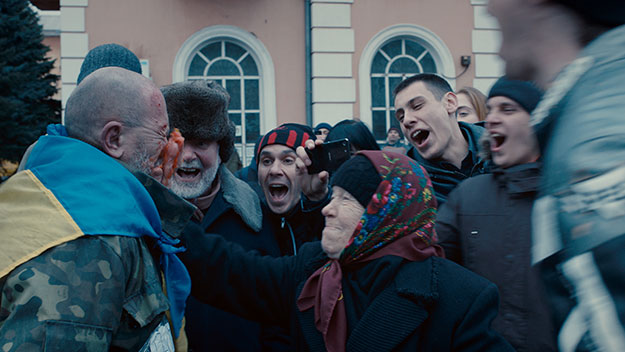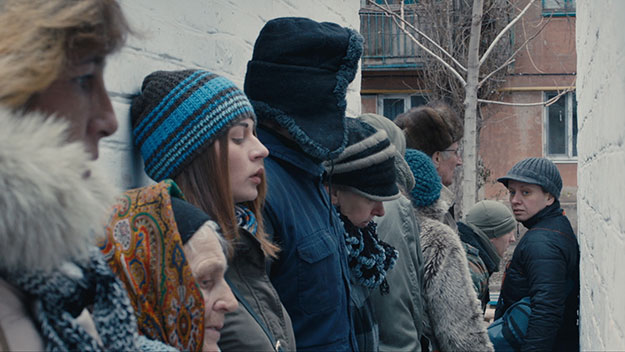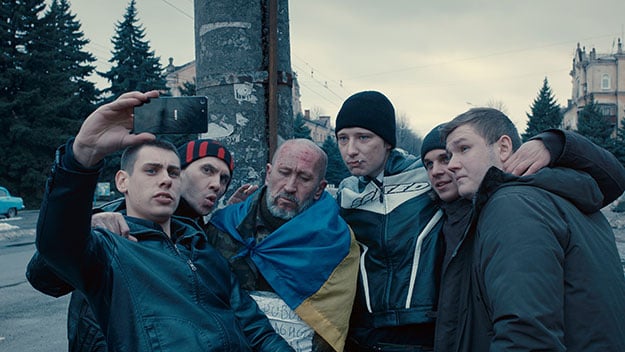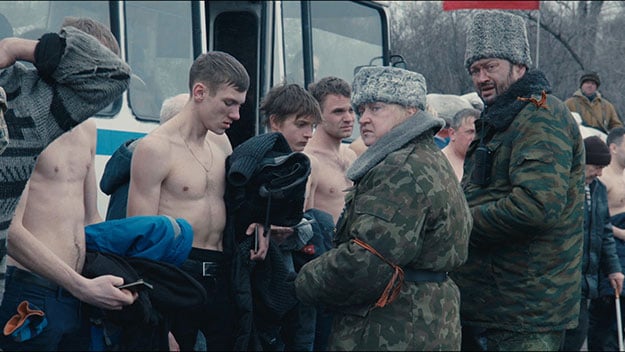It’s not uncommon for artists to experience tidal waves of productivity, but Loznitsa’s seems to be more about an historical and moral urgency than just creative inspiration. His films have always grappled with the extended aftershocks of post-Soviet society, with the unshakable presence of history, with omnipresent pessimism, with absurdist humor volleying with tragedy. But in light of aggressions by Putin’s Russia, and specifically the incursions and conflicts between Putin’s Russia and the Republic of Ukraine, the details and nuances of which are hardly known and understood outside of the region, Loznitsa has some stories to tell. Whereas two previous present-day narrative films, My Joy (2010) and A Gentle Creature, were given darkly ironic titles, the specificity of Donbass is notable and instructive, even as it shares with those films a peripatetic nature and pesky comedic tone. Loznitsa spoke to Film Comment on the roof of the JW Marriott Hotel in Cannes with an urgency to match that of his recent output, leaving his seat to crouch closer to me, and slipping into English when waiting for the translator so he could continue his train of thought.
Donbass seems much more direct, in terms of what it’s about, who it’s about, and when and where it takes place than the somewhat more allegorical and folkloric A Gentle Creature. It feels like a companion piece to your other film from the past year, the documentary Victory Day. All these films deal with the subject of decay and disintegration, the process that’s been taking place on the territory of the former Russian Empire ever since the Revolution of 1917. And all of these films contain traces, echoes, glimpses, reflections of the war. With this most recent film, it’s not a hint anymore. We shift from hints into direct naming. Because this is really something that happened, and it could be that my films present some kind of mirror image of what’s going on. The new element that makes this film different from previous films is that there is no protagonist whatsoever. [Characters] just completely disappear. It’s been a long time since I really wanted to try and experiment with such structure. I was inspired by the experiments of Eisenstein, and I used the same technique that Buñuel used in The Phantom of Liberty. It’s a collection of episodes, and in every one there is a character that moves us to the next one. And my intention was to have every episode of the film show one side, one manifestation, one aspect of this omnipresent process of disintegration and decay. Almost every episode has a documentary reference, in that there were people who filmed these types of situations—events that happened for real—with their mobile phones and then uploaded them to the Internet. And it feels that urgent. Perhaps this is the most malicious film I’ve done so far. Most evil. Let’s call it an angry film. Perhaps it’s because of my attitude toward this war. It’s different from an anger that builds over a lifetime, which might be fair to say about some of your previous films—perhaps My Joy—but this felt more in-the-moment. It’s a reaction, yes. You can feel that. It’s almost subconscious, it doesn’t happen voluntarily. It’s just a reflex. I react with anger. I don’t control this feeling. When I wrote the script and I started showing it around to colleagues, to funders, they were all really shocked by the text, how strong it is. They said, my god, if this is only how it is written, one can only imagine how it will look on the screen. One journalist from Australia told me the film was like a dark hallucination, and could not believe that something in real life could be like that. This is the impression of someone who has never experienced these things before, and who has this idea of a norm, what normal things are. With this kind of attitude, and with the camera framing things for you, there’s some kind of distance. You have this built-in understanding of what is normal.
The long takes in the film seem crucial here, in that there aren’t many cuts to save us from what we’re seeing. Do the long takes help establish a sense of verisimilitude, to preserve the sense of intensely lived space that you’ve fostered? Every cut one makes sends a signal to the spectator that it’s a story told by someone. So there is a manipulation, a manufacturing. Whereas a long take draws the spectators inside the situation and inside the frame and gives the impression that this is a here-and-now situation. There are moments in this film when you feel almost trapped in the shot. You’re waiting for a cut, but the space you’ve created seems scarily infinite. Do you mean in particular the scene of the beating? That’s one, yes. It could be with the beating scene [in which a handcuffed prisoner is seized upon by an increasingly violent mob] that there’s a physiological reaction, a kind of revulsion of not wanting to witness something like this. In general I followed the documentary references, but also within every scene there should be development. There should be a dramatic structure, a narrative within the scene. You have to allow it to happen and to unfold. Of course if you do it with one long take, you are limited by the style you choose. Every scene was filmed first as a master shot and then we also did various angles for cutting, for editing. But we only did this when we felt there would be a reason to focus on one particular aspect of what was going on. In every scene there is something you may find revolting, while there are also things that you may find attractive and want to continue watching. And of course each individual spectator has his own natural feelings, attractions, and repulsions. Perhaps it’s just my personal problem that I’m attracted to this ugliness and evil, that I don’t mind watching such things longer than somebody else. For example, in the texts of Dostoevsky, you can feel how he is actually inspired by evil. Maybe it belongs to the culture, to the Russian culture, which deep inside has this attraction to hell. Probably. Pyotr Chaadaev, the Russian philosopher said that perhaps the point of Russia as a nation, as a country, is to demonstrate to the rest of the world how not to live, what road not to take. So they put him into the mental hospital. Nobody wanted to listen. You’ve used the word “documentary” a few times to describe your approach to Donbass, and I wanted to return to that. The word I was actually thinking of while watching the film is “journalistic.” Because you’re dramatizing very recent things, and with great specificity, that I don’t necessarily know about. Every time I make a fiction film I want to come as close as close as possible to this borderline, this frontier between fiction and documentary.
Meanwhile in your actual documentaries… It’s the opposite way. It’s closest to fiction. Meaning the hyper-stylization, the formalism? Yes, the fancy camera. In every of one of my documentaries the point is not to show the image that flows past the camera—it’s about the concept, the intellectual ideas that I want to formulate. I was grateful that I had seen Victory Day recently, a film that requires the viewer to do some work to figure out what we’re watching—what each flag means, which insignia belongs to which group. Your films have always been deep dives into human behavior, condemnations of how we treat each other and use our societies and cultures against one another. Yet Donbass is notably precise about who’s doing what to whom. Disorientation is common—you may not immediately know who’s who—yet the evidence is also on the screen. These new films are very, very close. Victory Day was kind of like documentary casting, in that I could recognize the faces of the pro-Russian separatists [in the crowds]. The next film, which I’ve already edited, is a documentary. It’s based off of archival footage we discovered about the Stalin trials. It’s very interesting from a cinematic point of view because the length of the takes in the trial footage is like six minutes, static camera. You can feel the atmosphere, and also how this was possible. They say film is truth 24 times per second, but this is a lie 24 frames per second. All the accused, who were innocent, give evidence against themselves. And they know that they’re testifying against themselves, and they all know it’s a lie. So do the judges, the prosecutors—they absolutely know. They organized it. It is staged; it is theater. What I’m really interested in and concerned about now is this theatricalization, how the society of the spectacle comes forward. This is the subject I really want to research. Photography, which developed into cinema, which developed into television, apart from giving us immense joy and pleasure, has brought into our lives things that can be very dangerous. The moment the camera is involved, the moment the camera is used, there is immediately a division between the observer and the observed. Somebody who is performing and someone who is recording this performance. This is the ontology of the whole act of producing, of taking an image. This act in itself invites this division, invites this dislocation. Once we start perceiving the world, there are really two ways to perceive it—through our own eyes and through a screen. The reality doubles in a way. This one reality becomes a show, becomes a spectacle. Yet once we start, we forget about this duality. And once we start treating this show as life itself, this is where danger begins. We are trapped in this trick of perception. And though we are tricked, we’re also participating in the creation of this show. No show is possible without a spectator.
Once we developed ways of capturing what would seem to be reality and truth, it opened us up to lies and deceptions. It earns and subverts our trust. The purpose of art is to declare this, to inform us about the fictionalized nature of itself. It’s our responsibility to remind ourselves and people around us that it’s fiction, that art is fiction. The invention of cinema coincided with this explosion in art of cubism and expressionism, abstract art, Picasso, Dali, Duchamp. They were saying, “It’s not life, it’s art, you are wrong!” Announcing and flaunting its own artificiality. Yes, it’s a protest. Like a protest against the image occupation. So now you’ll have to do it again for us. Or at least remind us. Eric Hynes is a journalist and critic, and curator of film at Museum of the Moving Image in New York.



